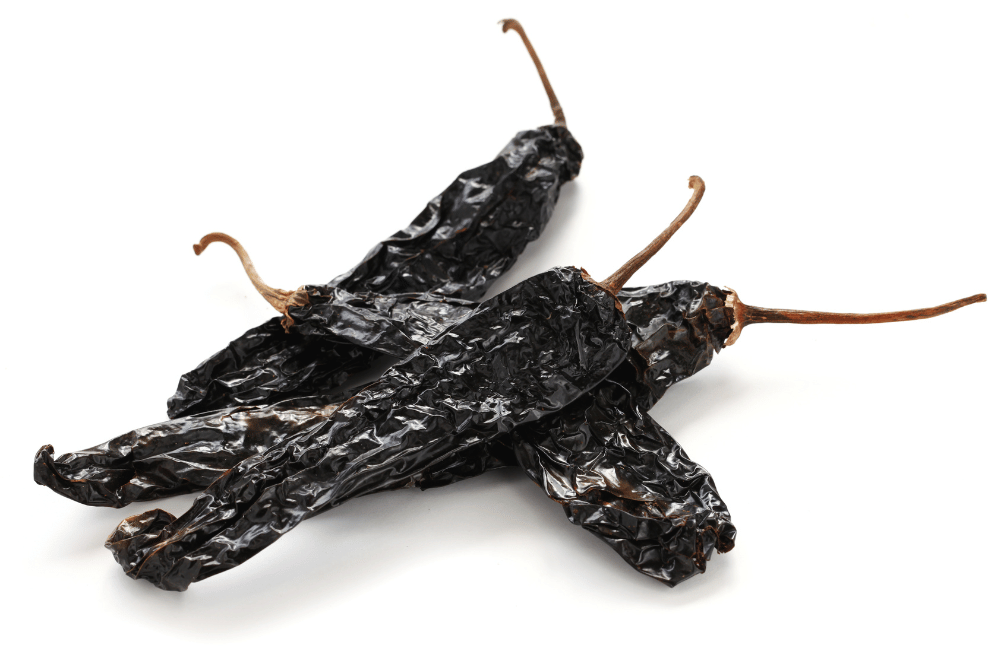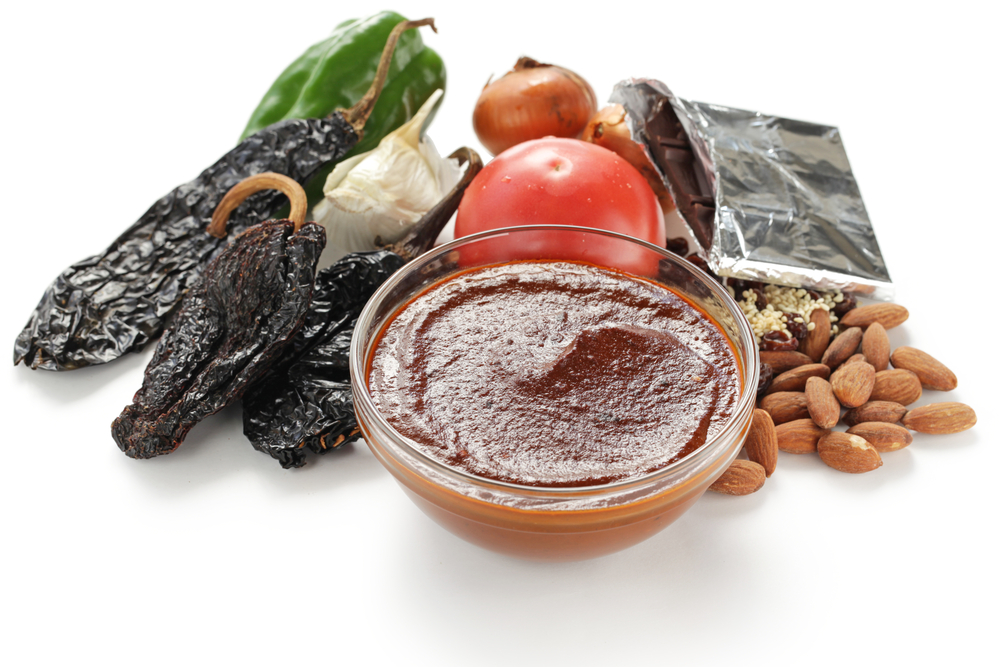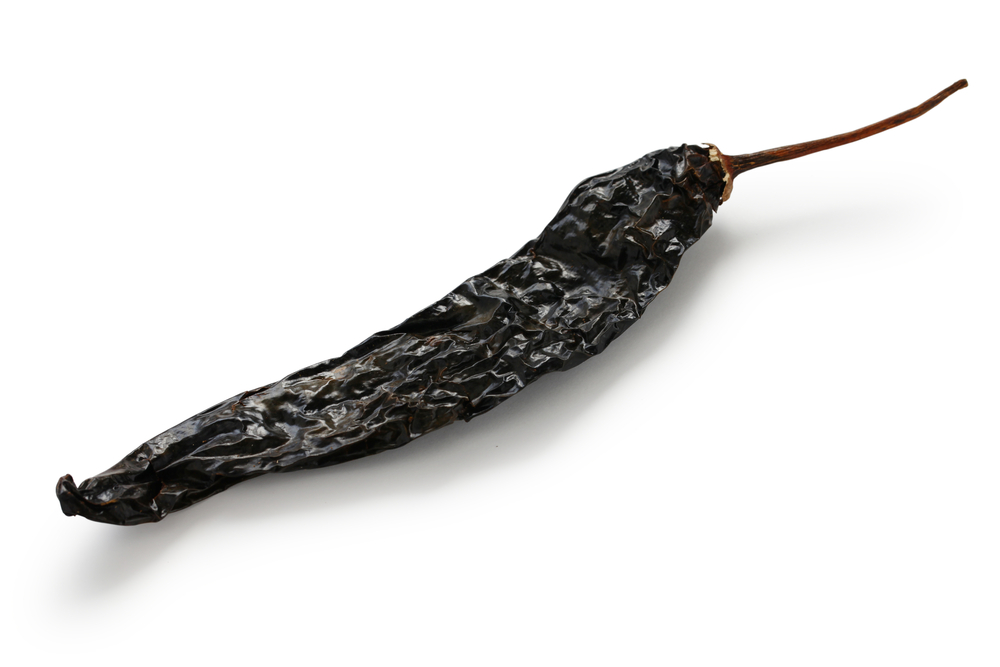Award-winning holy mole peppers were developed in the US as an alternative to pasilla peppers in Mexican mole sauces. However, they are much more versatile in both fresh and dried versions. They are disease-resistant, high-yielding, mildly hot, and flavorful.
What Are Holy Mole Peppers?
Holy mole peppers are a direct hybrid of chilaca peppers developed in the US as a more reliable alternative to pasilla chiles, which are part of the ‘holy trinity’ of hot peppers used to make mole sauces.
The holy mole pepper was such an excellent hybrid that it became an AAS winner in 2007 for its great flavor, disease resistance, high yields, and improved growth vigor.
Established in 1932 by W. Ray Hastings, All-America Selections awards new edible plant varieties for their superior garden performance and for raising home gardeners’ awareness.
Color
Unripe holy mole hot peppers are green, while the ripe ones have dark chocolate or chocolate brown color.
Mole sauces require the ‘holy trinity’ peppers in their dried, fully ripe form. Holy mole peppers can ripen to chocolate brown on the plant before they are harvested and dried to be used in various mole sauce recipes.
Size And Shape
The size and shape of holy mole peppers match their parent pepper—the chilaca pepper.
Like the chilaca, holy mole peppers are elongated, measuring 7-9 inches long and 1.5 inches wide. These sizes are potentially slightly larger than those of chilaca peppers, which are 6-9 inches long and one inch wide when fully mature.
Holy mole chili peppers have a long, conical, flattened to curved tapered shape that ends in a blunt point.
Texture
The skin of holy mole chili peppers is smooth and glossy. It flows over the peppers’ thick walls.
Taste
The name ‘holy mole’ applies to fresh and dried versions of the pepper, unlike the other peppers in the Mexican mole sauce, ‘ holy trinity.’
Both fresh and dried holy mole peppers have a nutty and tangy flavor. However, the tangy and nutty tastes are enhanced when the peppers are harvested at the dark chocolate stage and dried.

Chilaca Vs. Pasilla Vs. Holy Mole Peppers
Both pasilla and holy mole peppers derive from chilaca peppers—the former as the dried, ripe form of chilaca and the latter as a Capsicum annuum direct hybrid of chilaca chiles.
Chilaca peppers are from Puebla, Mexico, where growers cultivate them for their slightly sweet flavor and family-friendly heat level of 1,000-2,500 Scoville Heat Units. When fully mature, chilaca peppers have an earthy, slightly sweet taste with raisin-like undertones.
Chile pasilla means ‘little raisin’ in English. This refers to the pepper’s dark, wrinkled appearance and raisin-like flavor once dried.
As mentioned, chilaca peppers harvested when fully ripened to dark green are called chile pasilla. They are also called chile negro because of their dark, brownish-black color when dried.
Pasilla peppers have a sweet, earthy, fruity, smoky flavor with undertones of raisins and coffee or cocoa. Depending on growing conditions, they score 250-2,500 SHUs on the Scoville Scale. Most of them are in the 1,000-2,500 SHUs category.
On the other hand, holy mole peppers were developed as a substitute for pasilla peppers.
Holy mole chili peppers are also described as pasilla-type hybrid or hybrid pasillas because of their nutty flavor, which resembles the earthy flavor of pasilla peppers.
The ‘holy trinity’ of Mexican mole sauce features three peppers harvested when ripe and then dried:
- Ancho peppers. These are the ripe dried version of poblano peppers. They score 1,000-2,000 SHUs.
- Mulato chili peppers. These are the dried, overripened version of poblano peppers. They are the hottest peppers in the trinity, with a score of 2,500-3,000 Scoville units.
- Chile pasilla. These are dried, ripe chilaca peppers. These are now sometimes replaced by the holy mole pepper.
The holy mole is preferred as an alternative to pasilla chiles for two main reasons:
- Mole sauces use mature peppers, which ensures the flavor and heat of each pepper variety are at their peak. Even though holy mole peppers take about 110 days to ripen to chocolate brown, they produce more pods per pepper plant than chilaca peppers.
- Holy mole pepper plants are resistant to strain Y of potato virus and strains 0, 1, and 2 of tobacco mosaic virus (tobamovirus/TMV).
Some recipes may add a fourth pepper, chile guajillo, to the trinity. Guajillo chiles are the dried version of mirasol peppers. They have a Scoville score of 2,500-5,000 units.
How Hot Is A Holy Mole Pepper?
The nutty and tangy flavor of holy mole peppers balances well with the peppers’ mild heat of 700-800 Scoville Heat Units. Most of the peppers register 700 SHUs on the Scoville pepper heat scale.
The spice level of holy mole peppers is much higher than that of zero-heat sweet peppers like gypsy, California Wonder, and Carmen peppers.
Holy mole peppers are much milder than red jalapenos, which register 2,500-8,000 Scoville units.
What Are Holy Moly Peppers Used For?
The main culinary application of holy mole peppers is making Mexico’s famous mole sauce when they replace pasilla peppers. The peppers are harvested when chocolate brown and dried for more nuttiness and tanginess.
Mexican mole (MOH-lay) sauce is a dark reddish-brown cooked mix of garlic, chili peppers (including the ‘holy trinity’), cinnamon, onions, and a dash of Mexican chocolate.
Over 300 variations of mole sauces exist today, using different chili peppers besides ancho, mulato, and pasilla peppers.

Besides the mole sauce, the versatile holy mole hot peppers have the following applications:
- Fully mature holy mole peppers are dried and crushed into holy mole pepper flakes and chili powders.
- Flavoring soups and stews.
- The thick walls make holy mole peppers suitable for stuffing, although their slender profile limits this use.
- As a rub for meats.
- Flavoring wet rubs.
- As salsa or salad peppers, when harvested green.
- As sliced toppings for pizza, sandwiches, enchiladas, and tacos.
- As a salsa dip for appetizers.
- As pickled peppers when harvested fresh and green.
Where To Buy Holy Mole Peppers
You’ll hardly find holy mole peppers if you do most of your grocery shopping at supermarkets. They are easier to find online in dried and powdered forms.
How Do You Grow A Holy Mole Pepper?
Like other hybrid peppers, holy mole peppers are easy to grow and high-yielding because of their resistance to tobamovirus and potato virus strain Y.
You can grow your own crop from holy mole pepper seeds purchased from Amazon and online seed catalogs or young seedlings purchased at local gardening centers.
Establish the pepper seeds indoors 6-8 weeks before the last spring frost. Germination will happen in 10-20 days.
Once the frost danger has passed, transplant the seedlings outdoors in a sunny garden or large pots.
Holy mole pepper plants thrive in full sun and moist, well-drained soil. They grow as annuals, but they can be perennial if you overwinter them indoors in a sunny location.
It takes 85 days from transplanting to harvest green holy mole peppers and about 110 days after transplanting to reach dark chocolate maturity. The harvesting stage will depend on what you want to use them for.
Substitutes For Holy Mole Pepper
Where a mole sauce recipe or other calls for holy mole peppers and you can’t find any, you can substitute them with pasilla chiles, ancho chiles, guajillo, and mulato peppers.
You can also replace holy mole chilis with chilaca and poblano peppers if the recipe requires fresh peppers.

